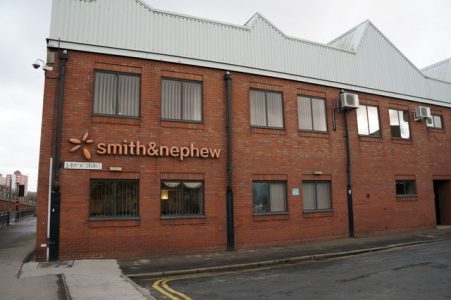The History of Smith & Nephew & Where it is Now
What is Smith & Nephew?
Smith & Nephew is a company that is known for manufacturing medical equipment. Since starting out in Hull, they have since moved their headquarters to Watford.
Learn about the origins of the humble sticking plaster and how it became the business that it is now.
Page Contents:
- The Beginning of Smith & Nephew
- How Smith & Nephew became what it is today
- Where is Smith & Nephew Now?
The Beginning of Smith & Nephew
In 1836, a man called Thomas James Smith decided to open a dispensing chemist’s shop when he was 30 years old. His shop was located on North Churchside in Hull’s old town area.
Thomas was proud to have been able to open his own dispensing chemist shop. He often described himself as an ‘Analytical and Pharmaceutical Chemist’.
15 years earlier, the Pharmaceutical Society of Great Britain was formed. After creating his business, Thomas soon became a member.
Thomas soon realised that he had a great interest in the curative properties of medicine. He was also a wholesale supplier of cod liver oil.
By 1875, Thomas was selling over £3,000 worth of cod liver oil which is roughly £368,840 in today’s money. He supplied major hospitals such as Guys and Great Ormond Street.
Thomas wanted to ensure that the cod liver oil he sold was of the highest quality. As a result, he decided to create an original refining and blending process.
His high standards for his cod liver oil became well known. In 1883, he won the gold medal at the International Fisheries Exhibition.
Thomas was nearing his 70th birthday in 1896. Soon his health began to deteriorate and he quickly realised that he was no longer able to run the business on his own.
As a result, Thomas took on his nephew. They called him Horatio Nelson Smith who, at the time, was 22 years old.
Thomas decided to rename the company T J Smith & Nephew three months before he died. His share of the business was left to his sister Amelia Ann.

A few years later, Amelia Ann decided that she didn’t want to be part of the business. She transferred her share to Horatio for an annuity of £260 which is £34,050 in today’s money.
By the beginning of the new century, Horatio became sole owner of the business. Before he joined his uncle, he worked in the textile industry and brought this knowledge to the pharmaceutical industry.
Horatio decided to buy a new machine from Germany. This enabled him to both cut and roll bandages with ease.
To further expand the business, Horatio travelled to North America, In 1906, he won a contract to supply bandages to Canadian hospitals.
By the following year, the business had become a limited company. As a result, the name changed to Smith && Nephew Ltd.
The business continued to expand after becoming a limited company and they decided to move to a larger premises. They were now located at 5 Neptune Street in the dockside area of the city.
By 1912, the company expanded again. They decided to buy a sanitary towel manufacturer and supplied bandages to the Turks in their war with Italy.
How Smith & Nephew became what it is today
During the First World War, the business greatly expanded. Demand for their bandages was continuing to grow as did their number of staff which started at 50 and went over 1,200.
They opened a new manufacturing plant in Canada. The business also decided to cut out the middleman and bought their own textile mill in Lancash*re.
When the war ended, so did the demand for their products. Their workforce went down to less than 200 members of staff.
However, Horatio was not deterred. He decided to shift his focus on the market that was overseas.
This led him to open the first independent overseas branch of Smith & Nephew. It officially opened in Canada in 1921.
The year of 1924 really boosted the company’s fortunes. The British government passed an Act calling for the provision of First Aid equipment in commercial premises.
Smith & Nephew started to produce their own range of First Aid Kits. This included a range of commercially produced plaster of Paris.
The company received their biggest break in 1928. This happened when Horatio decided to buy into a development.
It was a process for creating elastic adhesive fabric. This would revolutionise treatment of varicose ulcers and become one of the world’s leading support bandages.
Elastoplast was extremely successful. It remained a trademark of Smith & Nephew.
Since then, it has become a generic term for a sticking plaster in the UK, Canada, and New Zealand. This is similar to its main rival Band Aid in the US.
By 1937, they formed a new public company called Smith & Nephew Associated Companies Ltd. It concentrated on product development, manufacture, and supply.
The government called on Smith & Nephew again during the Second World War. They were asked to supply the troops with sufficient supplies of bandages.
After the war, the company began a programme to modernise the business. This is due to the demand of Elastoplast.
During the second half of the Twentieth Century, the company continued to grow massively. They acquired a number of global pharmaceutical and specialist medical companies.
Where is Smith & Nephew Now?
Since then, Smith & Nephew have continued to expand. They’ve bought many medical companies which have allowed them to enter different markets.
Some of these include: advanced wound management, ear, nose and throat, orthopaedic robotics to assist surgery, optical tracking technology, and partial knee implant.
Smith & Nephew are consistently listed in the FTSE 100 top companies on the London Stock Exchange. It continues to remain one of the largest firms to come out of Yorkshire.
The business expanded in 2009 which led to them opening a new factory in China. Some of their production has been relocated there.
During February 2012, the business was fined $22.2 million for multiple offences. These were caused by their US and German subsidiaries.
One of these offences was bribing doctors, who were government employed, to use their products. Not only did they pay the fine, they also agreed to a compliance monitor for 18 months.
People who travel down the Clive Sullivan Way will often see one of their factories. They know that the company is still very much present along the banks of the Humber Estuary.
Currently, the business has no signs of stopping. They continue to research and develop new products to create an impact on the medical world.

